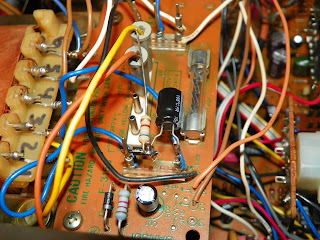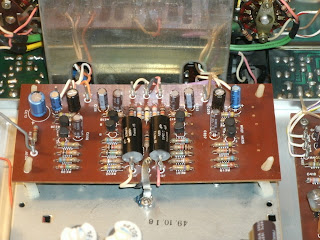Sansui AU-717 Integrated Amplifier
**had this nice write up finished and our digital camera went kaput', so here are some left over photos off the tablet, damn was that irritating...
For more photos reference below from our previous completed AU/TU 717 Restorations:
Wanted to do a little highlight on another AU-717 we had in. The AU-717 and TU-717 pair is truly a corner stone Sansui to own. The AU-717 has an impressive build quality. Incorporating a very nice enclosed stepped attenuator and painted redundant shielding throughout. The driver stages are well layout, with separate heatsinks and mirror topographies.
F-2663 Protection Assembly
This is kind of one the problematic areas of the Au-717. Some where along the manufacturer process something went astray, Every Au-717 we've had on the bench has had a host of cold solder connections on this Assembly, it also radiates some significant heat effectively toasting the joints as well. Using a microscope we can see rippling within the solder flow, this is a BIG indicator to me that the solder heats up, potentially liquifying to a degree and settling after cooling. This would explain the high rate of protection complaints within the Au717 as well. I highly suggest, as we do here, reflowing ALL soldered connections on the F-2663 assembly. This includes while replacing the relay, which takes a modern Omron MY4 pin drop in.


All electroltyics here were replaced with high temp (105C) low impedance/ high reliability Nichicon PW, Panasonic FC's along with Nichicon BP' type. its worth noted some rippling smoothing benefits can be obtained by increasing the capatince of electrolytics C07/08, C05/06, C09/10 und C11/12 to all 220 microfarad 63Vdc capacitors. Also note this board, like many Sansui's have quite a bit of caustic glue coverage, the larger the electrolytics…the more glue. This NEEDS to be removed now and all effected components. I will guarantee all resistor arrays within R07/08/R11/13 (10K 1/4) (mirrored) will need to be replaced along with R33/34 (22K) more than likely, fuseables at R14/15 should be updated to a non-fuse able, I suggest MOX type 1/2W. Also noted should be D604 glass pack diode VD1212, updating to a dual 4148 diodes. I would also recommend pulling the dual power transformer to get access to the full foil side of F-2663.
F2721/22 Driver Assemblies
I really like working on the driver stages of the Au-717, clean, symmetric layouts, easy to remove and diagnose out of circuit. Their are several updates that should be performed though. The Au-717 uses a dual FET (2SK97) initial gain stage tied to TR03/4 differentials, which should be updated to matched 992's and fast BJT ZTX694 at TR01/2 which forms the initial PP (push-pull) stages, the latter topography of darlington cascade design creates a SEPP (single-end push pull) topography, kinda neat. Like the above protection assembly, one needs to remove ALL caustic glue and associate components here, mainly around the larger electrolytics, high temp (105C) and low impedance electrolytics were replaced here. Not if biasing issues arise suspect VR03 off the bat if you confirm rail voltages, the 1K potentiometers can be problematic here. Modern OnSemi TO-3 are available for the Au717 as well (MJ15022/25 NPN/PNP pairs) A handful of general 4148s to update (1S2473's) and pulling a few 150 ohm fuse-ables does the trick.
Audio Adjustments
links bias F-2721
punkten (TP) + und - beim VR03 für 20mV
recht bias F-2722
punktet (TP) + und - beim VR03 für 20mV
F-2720 Tone Assembly
Again their are several glass pack VD1212's that were updated to dual 4148 diodes and several 82 ohm fuse-ables that again need to be replaced, preferably with MOX type. Each 82 ohm resistor had drifted well beyond a 10% parameter, fairly typical of them. Electrolytics were replaced with audio grade Nichicon KA's and Silmic II's. two coupling stage film pairs were replaced with .33 und .47 microfarad polypropylene Panasonic ECW film capacitors. Whats kinda nice about this board is you can fully remove the assembly along with the stepped attenuator at once for easy access.
F-2723 EQ Assembly
As above, the electrolytic were replaced with audio grade Elna Silmics and low impedance Nichicon PW's, the coupling films were replaced with 1 microfarad polypropylene Panasonic ECW film capacitors. Like the F-2720 assembly their are several 82 ohm fuse-ables that should be replaced in this stage as well, also like the F-2720 and the rest of the unit it uses a series of ribbon and molex connectors which is convenient.
























































